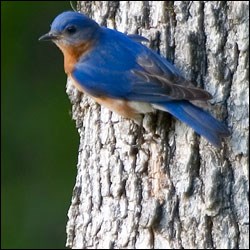
IntroductionThis pretty, bright blue bird with its cheerful song and insatiable appetite for insects has been a longtime favorite of birders, urbanites, and farmers. Despite its favored status, however, its existence was once threatened. Eastern bluebird populations declined rapidly in the last century, probably due to forestry practices that cut down snags and hollow trees that bluebirds used for nesting. But an aggressive campaign of providing nest boxes, eviction of house sparrows from nest boxes, and research have permitted bluebird populations to rebound. Their return is a conservation success story, but it is a story whose conclusion is not yet finished. Bluebirds are still threatened by aggressive, invasive species, such as house sparrows, that successfully compete with bluebirds for nesting cavities. Get InvolvedCheck out the North American Bluebird Society website to find out how you can become involved in helping bluebirds. Building a bluebird trail, a series of nest boxes in suitable habitat, is a great project for youth groups. Identification
|
Last updated: February 16, 2023
